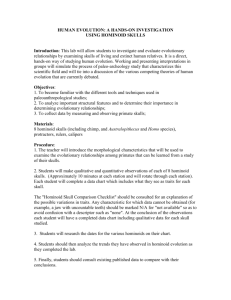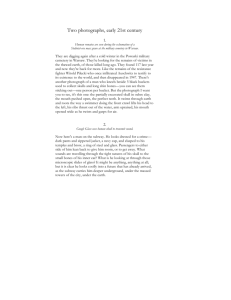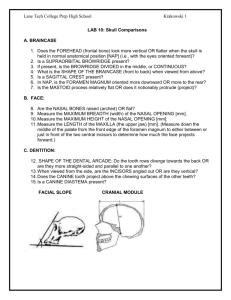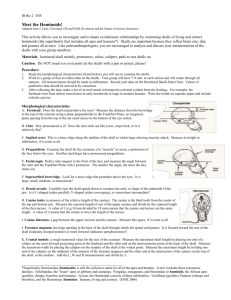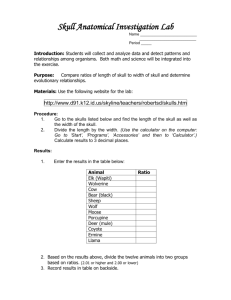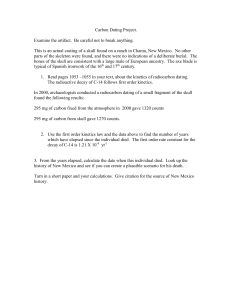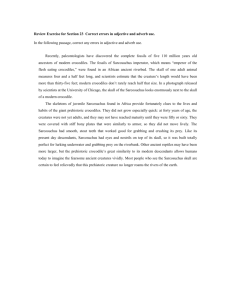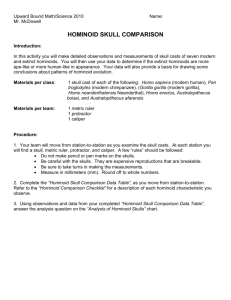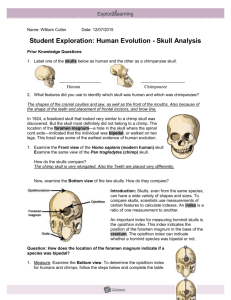Hominid Skull Activity
advertisement
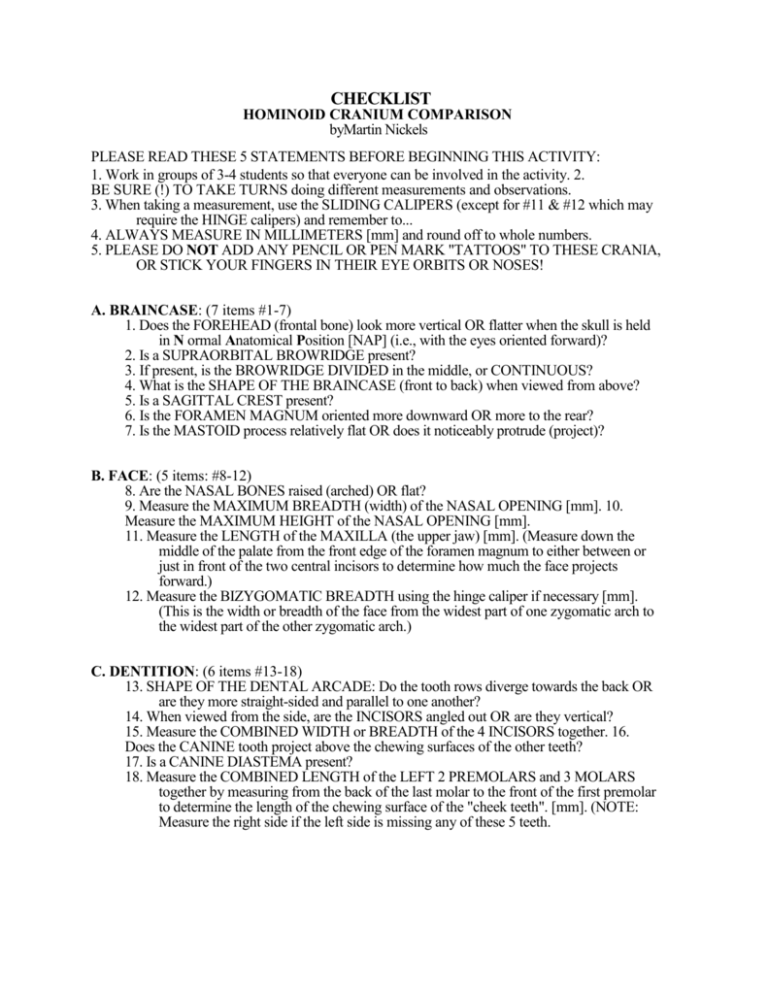
CHECKLIST HOMINOID CRANIUM COMPARISON byMartin Nickels PLEASE READ THESE 5 STATEMENTS BEFORE BEGINNING THIS ACTIVITY: 1. Work in groups of 3-4 students so that everyone can be involved in the activity. 2. BE SURE (!) TO TAKE TURNS doing different measurements and observations. 3. When taking a measurement, use the SLIDING CALIPERS (except for #11 & #12 which may require the HINGE calipers) and remember to... 4. ALWAYS MEASURE IN MILLIMETERS [mm] and round off to whole numbers. 5. PLEASE DO NOT ADD ANY PENCIL OR PEN MARK "TATTOOS" TO THESE CRANIA, OR STICK YOUR FINGERS IN THEIR EYE ORBITS OR NOSES! A. BRAINCASE: (7 items #1-7) 1. Does the FOREHEAD (frontal bone) look more vertical OR flatter when the skull is held in N ormal Anatomical Position [NAP] (i.e., with the eyes oriented forward)? 2. Is a SUPRAORBITAL BROWRIDGE present? 3. If present, is the BROWRIDGE DIVIDED in the middle, or CONTINUOUS? 4. What is the SHAPE OF THE BRAINCASE (front to back) when viewed from above? 5. Is a SAGITTAL CREST present? 6. Is the FORAMEN MAGNUM oriented more downward OR more to the rear? 7. Is the MASTOID process relatively flat OR does it noticeably protrude (project)? B. FACE: (5 items: #8-12) 8. Are the NASAL BONES raised (arched) OR flat? 9. Measure the MAXIMUM BREADTH (width) of the NASAL OPENING [mm]. 10. Measure the MAXIMUM HEIGHT of the NASAL OPENING [mm]. 11. Measure the LENGTH of the MAXILLA (the upper jaw) [mm]. (Measure down the middle of the palate from the front edge of the foramen magnum to either between or just in front of the two central incisors to determine how much the face projects forward.) 12. Measure the BIZYGOMATIC BREADTH using the hinge caliper if necessary [mm]. (This is the width or breadth of the face from the widest part of one zygomatic arch to the widest part of the other zygomatic arch.) C. DENTITION: (6 items #13-18) 13. SHAPE OF THE DENTAL ARCADE: Do the tooth rows diverge towards the back OR are they more straight-sided and parallel to one another? 14. When viewed from the side, are the INCISORS angled out OR are they vertical? 15. Measure the COMBINED WIDTH or BREADTH of the 4 INCISORS together. 16. Does the CANINE tooth project above the chewing surfaces of the other teeth? 17. Is a CANINE DIASTEMA present? 18. Measure the COMBINED LENGTH of the LEFT 2 PREMOLARS and 3 MOLARS together by measuring from the back of the last molar to the front of the first premolar to determine the length of the chewing surface of the "cheek teeth". [mm]. (NOTE: Measure the right side if the left side is missing any of these 5 teeth. Post Lab Questions: Please answer in complete sentences in your journal 1. Describe 4 features of a hominin’s skull that might suggest it was bipedal (walked on 2 legs). a. b. c. d. 2. Describe 2 features of the skeleton (not the skull) of a hominin that would suggest it was bipedal. a. b. 3. Why do you think the canine tooth reduced in size so much from earlier to later hominins? 4. Why do you think the face flattens over time in hominins? 5. How does the position of the foramen magnum relate to the body posture and locomotive pattern of the hominins? 6. What areas or portions of the braincase enlarge first and which ones enlarge later in the hominins? 7. What behavioral and cognitive (thinking) functions are associated with these cerebral areas of the brain? 8. Have we (Homo sapiens sapiens) really lost the browridge? 9. Why is it impossible for humans to have evolved from apes? 10. If you observe the fossil hominin skulls arranged from oldest to most recent, they generally show small differences from skull to skull. What does this observation suggest about the biological relationships between this organisms? 11. Is there any way to know if more than one of these hominins may have been alive at the same time? 12. What are the 2 most recent changes between Homo sapiens neanderthalensis and Homo sapiens sapiens (us)? HOMINOID SKULL COMPARISON CHECKLIST First fill in the name of each skull on your data chart. Then follow the checklist below to fill in the characteristics of each skull on the data chart. Record all measurements in millimeters. 1. Forehead: Does the skull extend above the eyes? Is the forehead large, small, or medium? 2. Chin: How pronounced is the chin? Does it stick out like yours or slope back? 3. Sagittal crest: This is the bony ridge along the top of the skull to which large chewing muscles attach. Is there a saggital crest? How pronounced is it? Is it large, small, or medium? 4. Prognathism: Examine the skull for existence of a "muzzle" or snout - a protrusion of parts of the face below the eyes. Gorillas (and dogs) have pronounced prognathism. Humans do not. 5. Facial slope: Use a ruler and protractor to measure the angle of the face as shown in diagram below. 6. Supraorbital browridge: Look for a bony ridge protruding above the eyes. Large, small, or medium? 7. Dental arcade: The arch, or shape of the jaw will be either boxshaped (sides parallel), "U"-shaped (parabolic sides), " V " -shaped, or intermediate. 8. Canines: The canine is the third tooth from the center of the top and bottom jaw. Describe them. Are they long, or short?; sharp, or dull? Is there a diastema present (a gap between the upper incisors and canines)? 9. Foramen magnum: This is the large opening in the base of the skull through which the spinal cord passes. The position of this hole reflects the body posture (and indirectly the locomotor pattern) of a hominoid. Is the foramen magnum located toward the rear or more forward? 10. Number of teeth--Top/Bottom: Count the number of teeth in the upper and lower jaw. Record number of incisors: canine: premolars: molars in one-half of the upper jaw as the numerator and the same count for one-half of the lower jaw as the denominator. 11. Cranial Module: Calculating the cranial module provides a rough numerical value for the size of the cranium. Measure the maximum length by placing one end of a caliper on the most forward projecting point of the forehead and the other end on the most posterior point at the back of the skull. The maximum width is determined with the calipers on the sides (temples) of the skull at the widest point. The maximum height is measured by putting the skull on its side; then hold one end of the calipers on the midpoint of the anterior of the foramen magnum and the other end at the intersection of the coronal and sagittal sutures on top, in the midline. Add these and divide by 3: FACIAL SLOPE CRANIAL MODULE HUMAN EVOLUTION DATA CHART SPECIMEN FOREHEAD CHIN SAGITTAL CREST PROGNATHISM FACIAL SLOPE BROW RIDGE DENTAL ARCADE CANINES N AME: FORMEN MAGNUM #OF TEETH TOP/BOTTOM _________ _________ _________ _________ _________ _________ _________ _________ _________ _________ CRANIAL MODULE AGE
